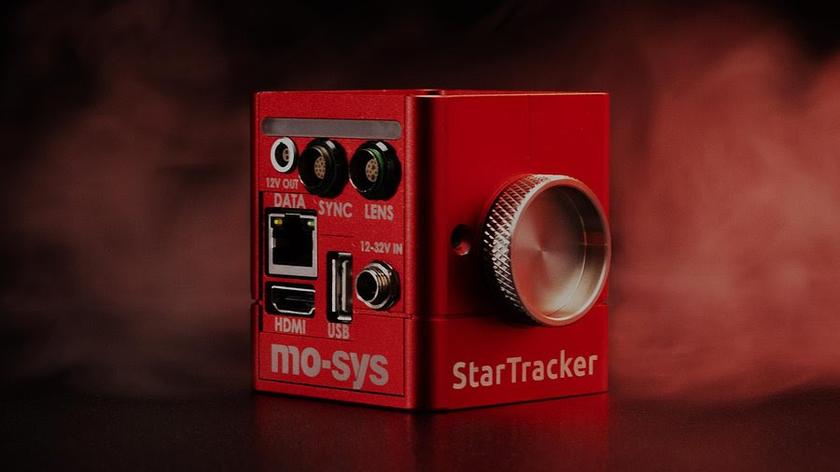Comparing Antennas for Indoor Reception
Recently I have been comparing some new indoor consumer TV antenna designs with a few old favorites. The new antennas in my collection are a Channel Master Smartenna and an inexpensive Antop AT-202B with switchable preamp and LTE filter. The old favorites are the Winegard Freevision HD30, which may show up under different model numbers, and an original Mohu Leaf.
OUT WITH THE OLD, IN WITH THE NEW?
The new antennas have some amplification, the two old ones, as tested, don’t. I’ve been recommending the Winegard HD30 as it is widely available at most Home Depot stores and it can be mounted outdoors or used indoors. It also provides some high VHF reception in a compact design. It is too big to take with me on the road, so the flat Mohu Leaf has been my travel antenna.
I learned about the Antop AT-202B while attending the ATSC 3.0 demo I reported on earlier (“ATSC 3.0 Progress Report,” July 2018). The WRAL engineers were surprised how well the little antenna worked so I gave it a try. It is available on Amazon and eBay. It has a preamp and LTE, but includes a switch so the preamp can be turned off. It is wired into the coax so it cannot be physically bypassed. It is quite small—Fig. 1 shows it mounted on a hotel curtain on a recent trip to San Jose using some rubber bands and binder clips. The binder clips are another tip I learned at the WRAL demo. They work quite well!
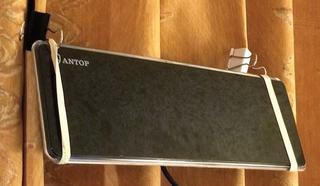
Performance at a hotel adjacent to the San Jose International Airport was excellent on UHF and high-VHF, but the eleventh floor room probably helped that. Carrying the power supply was a hassle so I used a USB-to-coaxial power plug to provide the 5V the antenna needs from my four-port USB changer.
The Channel Master Smartenna is interesting in that it can make adjustments to the antenna pattern, with seven patterns available. The best pattern is selected after it does a scan through VHF and UHF channels to find the optimum pattern for the location. For the spectrum plots and channel scan results I used the pattern the Smartenna selected as best overall. The large Wall Wart power supply, which has the F connectors mounted on it, makes this a difficult antenna to use on the road.
TESTING AND RESULTS
For the measurements, the antennas were placed one by one in the same location on a wall in a second floor apartment in West Los Angeles. To receive Mount Wilson 25 miles away, the signal has to pass through three walls. The I-10 freeway was about the same height or a bit higher than the antenna. The spectrum plots were created with an Airspy R2 SDR and the Spectrum Spy analyzer app. SDR gain was adjusted to place the noise level of each antenna at approximately 70 dBm on the scale so levels should be considered relative to noise, not absolute power.
Fig. 2 shows the spectrum plot for Channels 7–13 from the four antennas. Notice that the Smartenna did a great job with Channel 7, but like the Winegard HD30, had significant multipath distortion on Channel 11. As you can see, performance varied widely depending on channel.
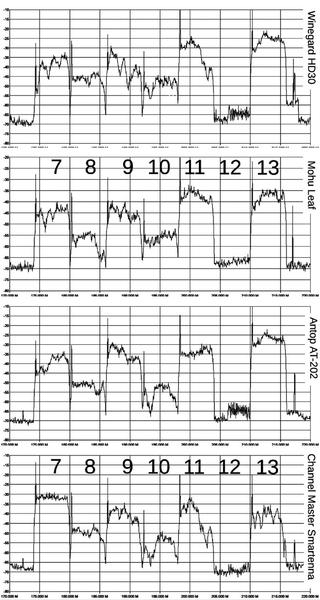
Fig. 3 shows the UHF spectrum for Channels 22–36 with similar variable results. What’s surprising is how well the LPTV stations performed. I suspect that is due to their use of low elevation gain antennas.
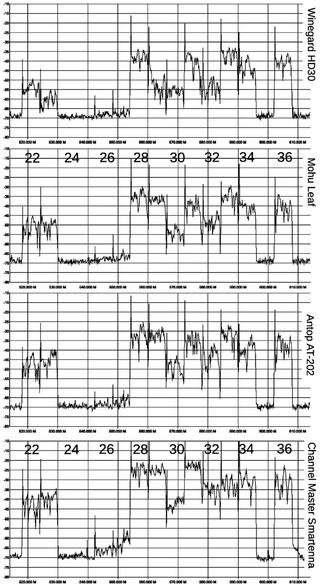
The appearance of the signals on the spectrum plot didn’t always equate to good reception. The Antop AT-202B (preamp on) received 24 RF channels. The Winegard Freevision HD30 received the same channels, with the exception of Channel 23, LPTV station KSMV-LD. The Mohu Leaf and Channel Master Smartenna missed VHF Channel 10, KIIO-LD, as well as KSMV-LD on Channel 23. (Results with stations are shown in Table 1.) Overall, I would say all four antennas did a good job.
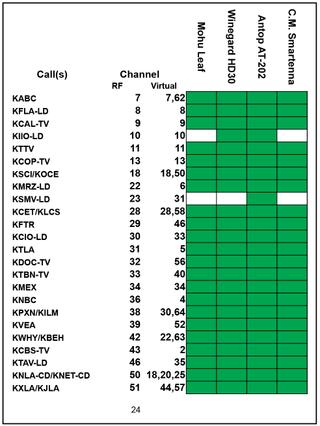
A small adjustment might have helped these three antennas pick up the missed channels. I suspect the Smartenna would have had better luck with these two channels if I had selected a different antenna pattern. Due to the antenna test location and limited time for the testing, I wasn’t able to run scans for the other six patterns. The pattern can only be changed by pressing a button on the bottom of the antenna multiple times. Using the waterfall display available in the Spectrum Spy app, I was, however, able to catch a plot of the signal strength and ripple for each of the seven patterns at UHF as it tried them.
The waterfall plot is shown in Fig. 4. As you can see, one of the patterns had slightly higher signal strength on Channel 23. The impact of the pattern changes on some channels is quite significant. The top of the display is the pattern the antenna selected after completing its scan.
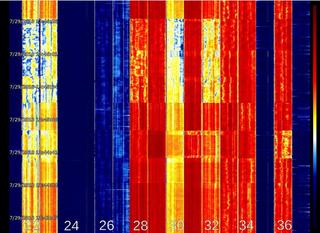
One troubling thing I noticed was that LED lights had a real impact on high-VHF reception from any antenna. During the testing, I switched on a ceiling light with Feit LED lamps and the VHF LPTV stations disappeared from the scan. Switching on some older GE LED lamps in an adjacent room in line with the antenna caused problems for one or two of the full-power VHF stations as well. LED bulbs could be a problem for stations moving to VHF, especially LPTV stations.
I’ll run some more tests if there is interest. I have a log-periodic lab-quality UHF antenna that I can use for comparison once I figure out how to mount it at the test location. During testing I didn’t reposition the antennas; it’s quite possible that might have allowed all four antennas to receive 24 RF channels from Mt. Wilson.
As always, your comments and questions are welcome. Email me atdlung@transmitter.com.
Get the TV Tech Newsletter
The professional video industry's #1 source for news, trends and product and tech information. Sign up below.

Doug Lung is one of America's foremost authorities on broadcast RF technology. As vice president of Broadcast Technology for NBCUniversal Local, H. Douglas Lung leads NBC and Telemundo-owned stations’ RF and transmission affairs, including microwave, radars, satellite uplinks, and FCC technical filings. Beginning his career in 1976 at KSCI in Los Angeles, Lung has nearly 50 years of experience in broadcast television engineering. Beginning in 1985, he led the engineering department for what was to become the Telemundo network and station group, assisting in the design, construction and installation of the company’s broadcast and cable facilities. Other projects include work on the launch of Hawaii’s first UHF TV station, the rollout and testing of the ATSC mobile-handheld standard, and software development related to the incentive auction TV spectrum repack. A longtime columnist for TV Technology, Doug is also a regular contributor to IEEE Broadcast Technology. He is the recipient of the 2023 NAB Television Engineering Award. He also received a Tech Leadership Award from TV Tech publisher Future plc in 2021 and is a member of the IEEE Broadcast Technology Society and the Society of Broadcast Engineers.


